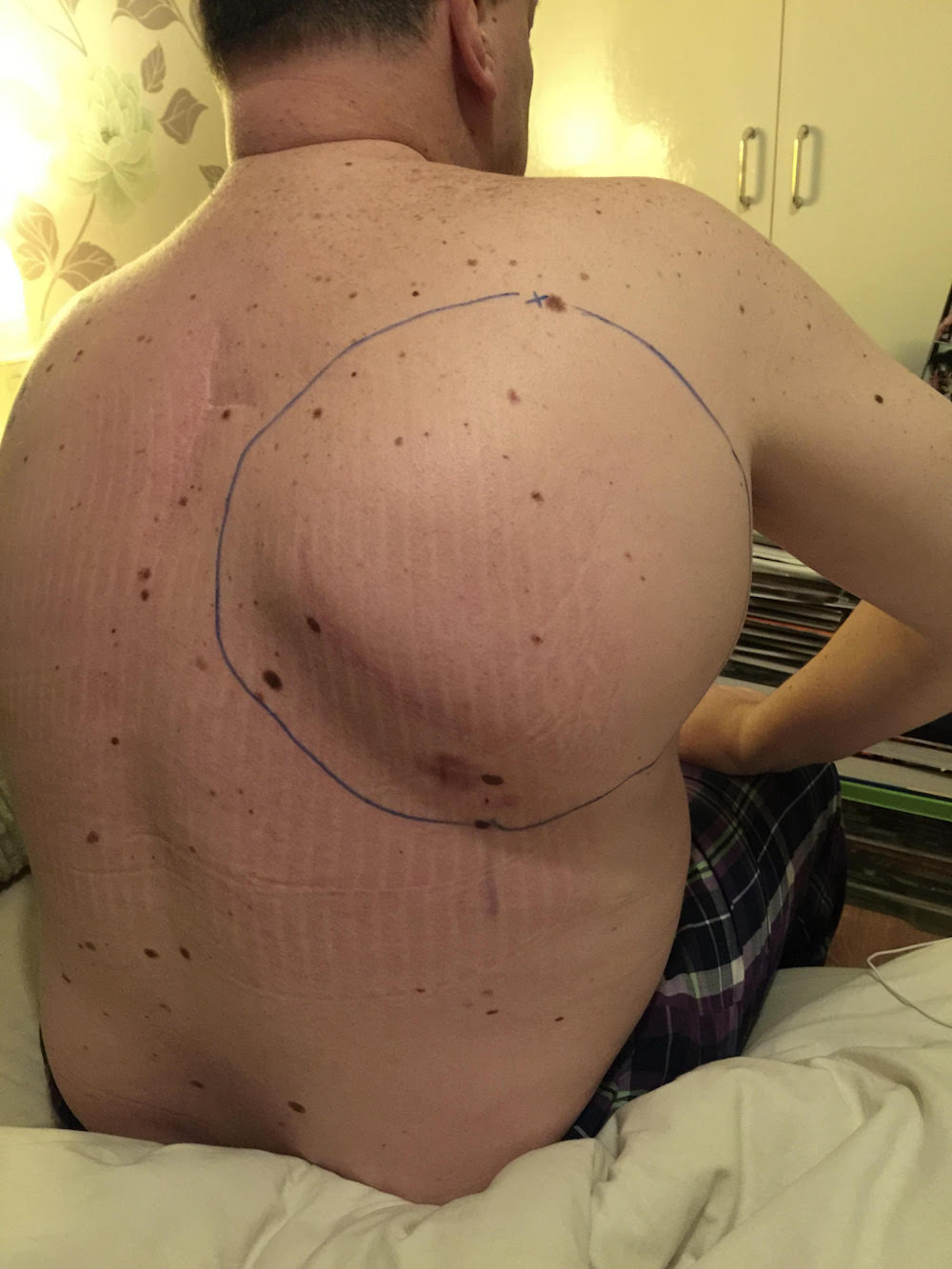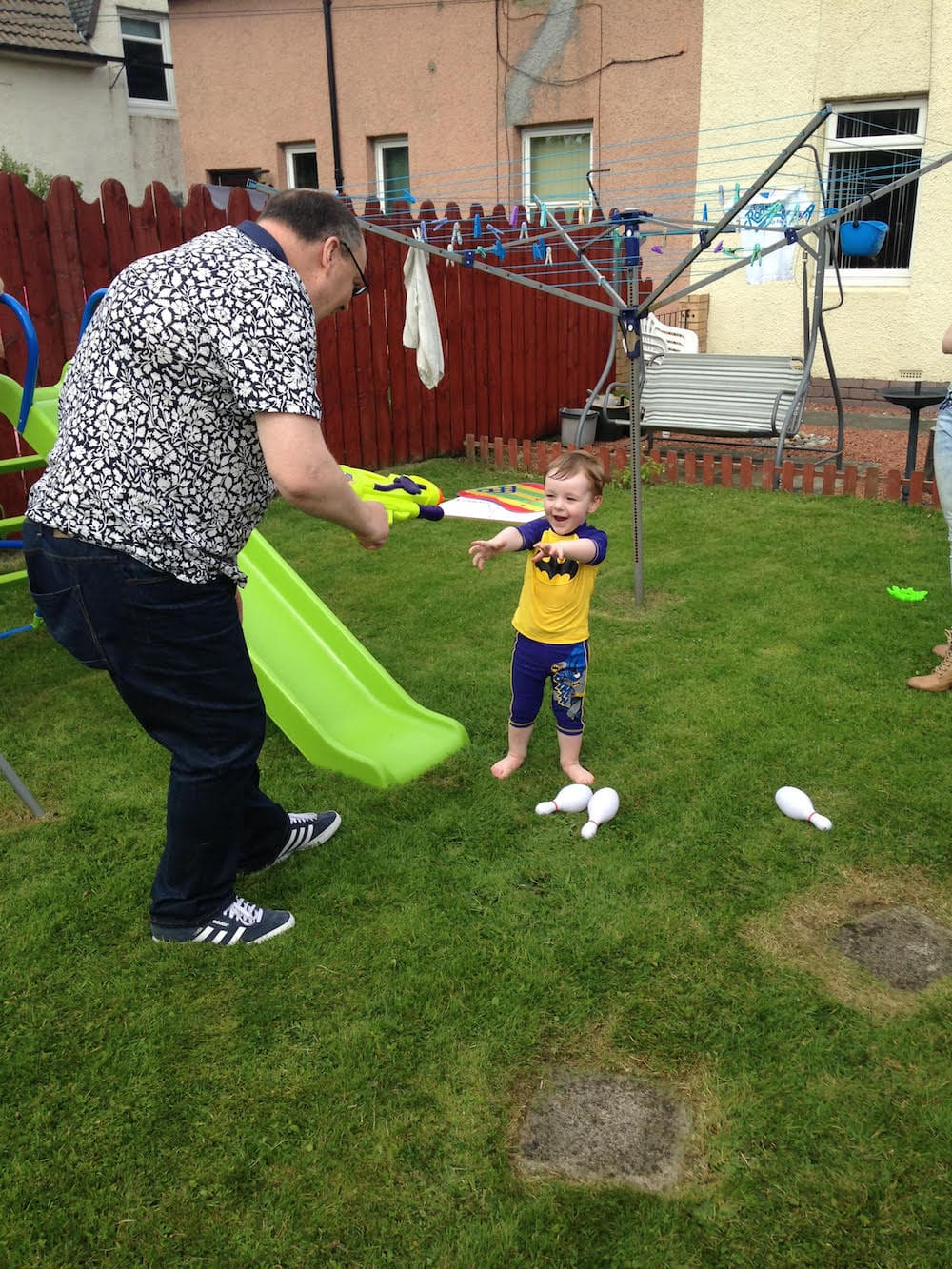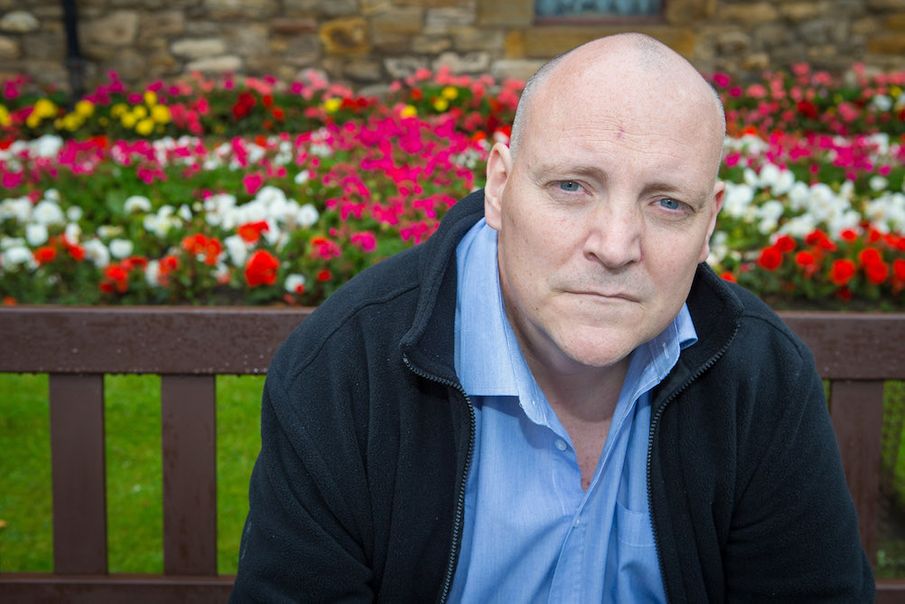Since 2006, Kevin O’Neil has endured excruciating chronic pain, but struggled to get a diagnosis. He persevered and discovered he had a tumour on his spine – news that he actually found to be a relief; he finally had an answer. After years of treatment for both depression and multiple tumours, one of which is so rare that only 15 people in the world have it, Kevin is focusing on the positives in life
Remembering significant dates like birthdays or anniversaries, as my wife Kirsty will testify, has never been something I’ve been good at. That’s not down to ill health – it’s just how I’ve always been. But there are two dates that I’ll never forget: Wednesday 7 October 2015 is the day the NHS saved my life by removing a 10lb (4.5kg) tumour from my back.
The second date, Saturday 7 November 2015, is the day I learned how rare my illness is. On this day, I was told I am only one of 15 people worldwide diagnosed with Malignant Myopericytoma.

Kevin's back
My chronic pain began in 2006, and for three and a half years I was constantly at my local medical centre in Fife. But despite numerous investigative procedures, many times Kirsty would have to call for an ambulance due to my extreme, unexplained pain.
It didn’t help that during this period, I was being misdiagnosed. In January 2007, I was told that I had problems with my liver, so the majority of procedures were based around this. Then, a CT scan and two MRI scans later, in 2010 I was told I had a “paraspinal” tumour.
In the past, I’d had some health professionals ask if the pain could be “psychological” and “was it all in my head”? So while some people will find it strange, I can remember smiling when I received the news. Kirsty was beside me and I finally knew what was wrong – those were reasons to smile.
In January 2011, I had surgery to remove the tumour; a thoracotomy, which lasted nine hours. My surgeon told me the tumour was roughly the size of an orange. When it was removed it “collapsed” due to several cuts and tears, and it had been these cuts causing my extreme pain when they “bled” into my system.
To date, I’ve had five major operations. The second was in October 2011, due to a re-occurrence of the tumour, when I had several small bones removed from my spine in order for the surgical team to fully remove it. A titanium plate now holds my spine together.
I am only one of 15 people worldwide diagnosed with Malignant Myopericytoma
Then in July 2014, I had surgery to realign the plate after it slipped on the T5 & T6 vertebraes. I had a further two operations, including one on a large haematoma in February 2016.
But the big one was my memorable date: Wednesday 7 October 2015. This was when I had “life-saving surgery” to remove another massive tumour.
Originating on the right side of my chest wall, over a roughly 12-week period, the tumour grew so much and so fast that it ended up pushing on my shoulder blade. “It’s shaped like a dinner plate Kevin,” my oncologist said. I would often laugh to Kirsty, family and friends: “Dinner plate? More the size of a f**king casserole dish!”
The surgery lasted 12 hours, and to take out the tumour, the majority of the rib cage on the right side of my body had to be removed, along with a large part of my right shoulder blade. The surgery also included a rebuild of my chest. I spent two and a half days in a medically-induced coma in the Intensive Care Unit (ICU), and staff were concerned that my right arm might be paralysed. Thankfully that’s not the case, but I do have limited use of my right arm.

Kevin and Nathan
One morning, the doctors told me the tumour weighed 10lb and was being examined in the pathology lab. Prior to surgery, I’d given permission for the medical photographer to take pictures, but when I first saw the images I could scarcely believe what I was seeing; the tumour was massive.
It was weeks later – 7 November 2015 – before I would hear the results. The oncologist rang to explain the tumour was something that the pathologists hadn’t seen before. They sent it to specialists in Glasgow and London, before it finally arrived in the US, and was diagnosed as a Malignant Myopericytoma. I was told that it was exceptionally rare. So rare, in fact, that I was only one of 15 people in the world with this condition. I just couldn’t take this news in.
At the time I was working as an official for the public sector trade union, Unison. My sick record was, as you might imagine, poor.
Between the first operation and my fifth one, I was also diagnosed with depression. I can remember thinking: “Great, what bloody next?” I am quite open when it comes to me talking about my general health and wellbeing, but I wanted this kept between family and friends. This was nothing to do with the stigma around mental health, it was just I already had so much going on with my health, I didn’t want to discuss it.
I’d say, all things considered, both Kirsty and I took the news about how rare my tumour was pretty well. My way of coping was to focus on the positives and realise I am still living, and I’m still here for Kirsty and our son Nathan.
It was a few weeks after that phone call that I thought about starting a campaign to find the 14 other people. One of Fifteen is an online forum where we can speak to each other and share how to cope with the pain. It’s also a way for me to thank the NHS for saving my life, and highlight how great they’ve been with dealing with both the physical side and mental side of my illness.
My favourite rock band, Marillion, have also really supported me with this campaign, which means so much to me since I’ve been a fan of theirs since I was 12!

Kevin with Marillion
NHS Fife have been fantastic in supporting my depression, with a mental health Community Practice Nurse (CPN), Wendy, visting me roughly every four weeks. I feel really positive after seeing her.
I’ve also had excellent support from the Scottish Association for Mental Health, and have agreed to be a volunteer with their peer support service soon, which I’m really looking forward to.
These days, when people ask how I’m doing, I explain that I deal with severe chronic pain 24/7 so some days are better than others, but then I can have a “pain flare-up”.
My family have been affected in many ways, with Kirsty altering her work-life balance in order to support my care. At times, she is the only one who understands my level of pain, and we’ve become stronger as a couple because of this. We also wouldn’t be where we are without the support of both our families, who have pushed me to keep fighting.
Despite being only four, Nathan has adapted really well to seeing the countless times I’ve been hospitalised; he understands the difference between being sick and daddy’s illness, and makes us extremely proud.
I’ve been medically retired since October 2015 – I was 46 at the time. Kirsty has dropped hours at her work to look after me and Nathan, as I am so restricted in what I can do. I love her so much and I can never thank her enough for what she does for us. I do not know where she finds her strength.
I will also never be able to thank NHS Fife and NHS Lothian enough, for keeping me living.
To hear more about Kevin’s One of Fifteen campaign, check out his blog at oneoffifteen.com
Despite life-saving surgery, and ongoing chronic pain, Kevin’s managed to remain positive by utilising the support networks around him – the NHS, family, and friends. Reaching out to the other 15 people with this rare tumour was a beneficial step. Talking to others going through a similar experience can really help, and through these constructive outlets, Kevin was able to acknowledge his feelings, while giving something back to those around him – a model that can work for us all.


Comments